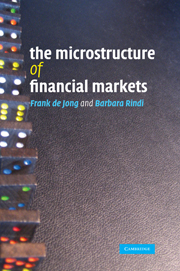Book contents
- Frontmatter
- Contents
- List of figures
- List of tables
- Preface
- Introduction
- 1 Institutions and market structure
- 2 Financial market equilibrium
- 3 Batch markets with strategic informed traders
- 4 Dealer markets: information-based models
- 5 Inventory models
- 6 Empirical models of market microstructure
- 7 Liquidity and asset pricing
- 8 Models of the limit order book
- 9 Price discovery
- 10 Policy issues in financial market structure
- Index
9 - Price discovery
Published online by Cambridge University Press: 05 June 2012
- Frontmatter
- Contents
- List of figures
- List of tables
- Preface
- Introduction
- 1 Institutions and market structure
- 2 Financial market equilibrium
- 3 Batch markets with strategic informed traders
- 4 Dealer markets: information-based models
- 5 Inventory models
- 6 Empirical models of market microstructure
- 7 Liquidity and asset pricing
- 8 Models of the limit order book
- 9 Price discovery
- 10 Policy issues in financial market structure
- Index
Summary
In the foregoing chapters we have seen that in the short run, the prices of financial instruments may deviate from their fundamental value on account of microstructure frictions such as bid–ask bounce, inventory control and order imbalances. Chapter 6 introduced empirical models for estimating transaction costs and the price impact of a trade. These models were quite simple: they assumed that the price impact of a trade was immediate. In reality, this is not always so, and there may be lagged effects or slow adjustments. We therefore need a richer dynamic structure in order to model prices and trades on financial markets. In this chapter, we introduce dynamic time-series models for prices and trades, and show how they can be used to describe the market's convergence on the new equilibrium price after a shock.
This chapter extends the simple empirical models of Chapter 6 to a full dynamic setting. We show how time-series models for prices and trades can be used to study these questions. Throughout the chapter, we focus more on the structure and interpretation of the models than on the econometric and sampling issues that often arise in estimating dynamic time series using microstructure data. Section 9.1 introduces a dynamic model for prices and order flow, with lagged effects of order flow on prices and order-flow dynamics. Section 9.2 generalizes that model to the vector autoregressive model, which was introduced into microstructure by Hasbrouck (1988, 1991, 1993, 1995) and has since become the standard reference model in the literature.
- Type
- Chapter
- Information
- The Microstructure of Financial Markets , pp. 159 - 179Publisher: Cambridge University PressPrint publication year: 2009

